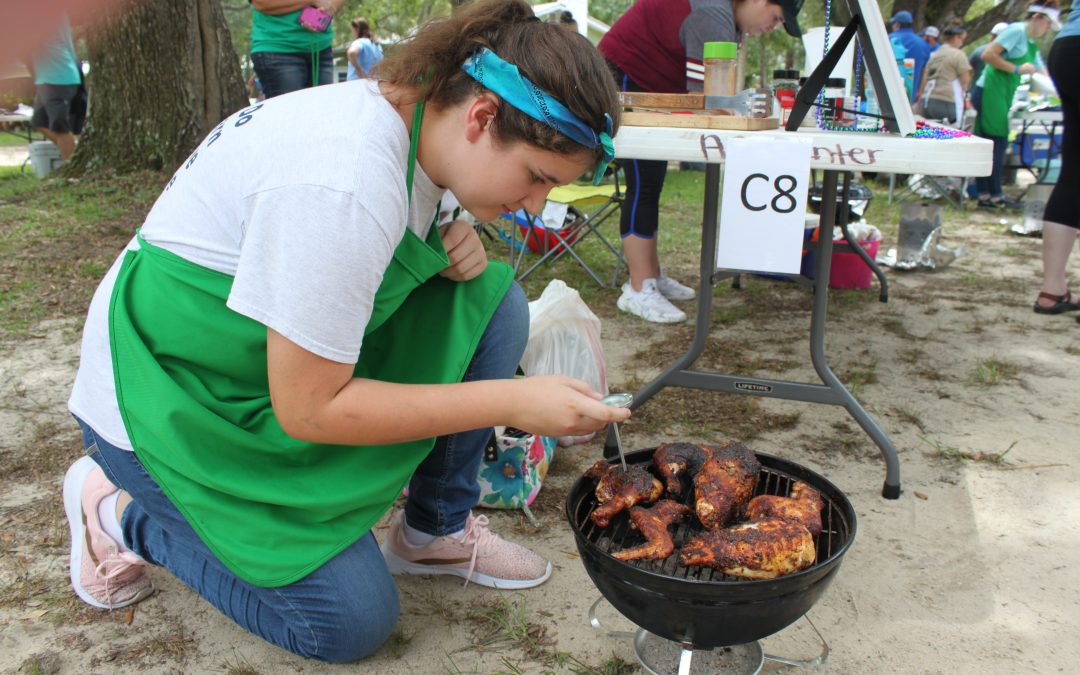
by bestevez | Sep 20, 2019
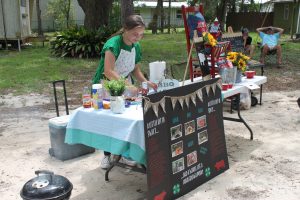
A youth competing in the NW District Tailgating Competition carefully prepares her protein.
Did you get to do any grilling this summer? Over 110 youth from throughout the Florida Panhandle participated in 2019 4-H summer day camps that taught them how to grill, food and fire safety, and cooking skills.
Ten different FL Panhandle counties provided nine unique day camps on grilling. Then, on July 20, 2019, 37 youth from eight counties participated in the Northwest District Tailgating Contest at the Washington County Ag Center. Youth participated in competitions in beef, pork, poultry, and shrimp divisions and were judged on their food and fire safety skills around the grill and the taste of their chosen protein. In all, $3,200 was awarded to Panhandle youth for placing 1st– 4th in their competitions.
Now, the top two youth in each protein category will compete at the Florida 4-H Tailgating Contest in Gainesville on September 28th. They will compete against youth from across Florida for an opportunity to win college scholarships. For the state contest, the first place winner in each protein area receives a $1,500 college scholarship and the second place winner receives a $1,000 college scholarship. September 28th is also the 4-H Day with the Florida Gators. You can get tickets for the football game for just $20 and sit with 4-H members from around the state. For more information, visit http://florida4h.org/blog/4-h-day-at-florida-gators-football-vs-towson/.
Join us as we cheer on the following NW District 4-H participants as they represent us at the Florida 4-H State Tailgating Contest:
- Beef Division
- Colton Serpas-Washington County
- Alan B.-Escambia County
- Pork Division
- Lillian Sparks-Washington County
- Brent Young-Holmes County
- Poultry Division
- Sarah Crandall-Jefferson County
- Rylee Sweat-Walton County
- Jamison Scheffer-Washington County
- Shrimp Division
- Claire Diamond-Escambia County
- Evelyn Moyers-Bay County
If you are interested in furthering your grilling skills, please check out the Florida 4-H Tailgate Series of EDIS documents at https://edis.ifas.ufl.edu/topic_series_florida_4-h_tailgate. If you would like more information on the Tailgating Contest so you or youth that you work with can participate next year, please visit http://florida4h.org/programsandevents_/animalscience/4-h-tailgating-contest/.

by bestevez | May 29, 2019
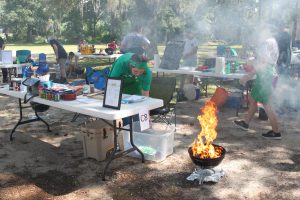
A 2018 NW District 4-H Tailgating Contest participant prepares to grill
Imagine the smell of a charcoal grill on a breezy summer day. A neighbor is grilling in their backyard, and you wish you were invited over for dinner. Would it be even better if it was your child or grandchild doing the grilling for you?
Fire up Your Grill!
4-H members have been firing up their charcoal grills and participating in the Florida 4-H Tailgating Contest since 2016. Designed to promote the use of animal protein in the diet, youth learn the art and science of safely preparing beef, pork, poultry, and seafood in an outdoor setting providing opportunities for 4-H youth to develop life skills, including decision making and healthy lifestyle choices.
In the Florida 4-H Tailgating Contest, youth grill two, 6-8 ounce portions of one of the following proteins:
- beef
- pork
- poultry – turkey breast or half chicken
- shrimp – fresh, headless and de-veined
While youth are grilling, judges observe food and fire safety actions and ask questions about the recipe and safety knowledge. A team of judges evaluates the cooked product by taste testing and scoring each entry.
4-H Tailgating District Contest
After youth compete at county contests or participate in day camps, they can register for the district contest. There are four district contests hosted throughout the state including our Northwest District contest held at the Washington County Ag Center on July 20, 2019. Cash prizes at the district level are awarded in each protein category – 1st place $400, 2nd place $250, 3rd place $100 and 4th place $50.

Scholarships and prizes are awarded thanks to these sponsors.
4-H Tailgating State Contest
The top two winners from each protein are then eligible to compete in the state contest held at the University of Florida on September 28, 2019. For the state contest, the 1st place winner in each protein area receives a $1,500 college scholarship and the 2nd place winner receives a $1,000 college scholarship.
Since the Florida 4-H Tailgating contest began in 2016, over $63,000 in scholarship money has been awarded to Florida 4-H members made possible by sponsorships from Winn-Dixie, National Beef, and Sonny’s.
Learn More at a Tailgating Day Camp
Last summer, over 100 youth attended day camps to learn about identifying cuts of meat, preventing food cross contamination and food-borne illnesses, grilling techniques, food safety and fire safety. Contact your local UF/IFAS Extension office to find a grilling day camp near you so you can participate in the 2019 Northwest District 4-H Tailgating Contest! Follow us on Facebook to see event details!
Resources
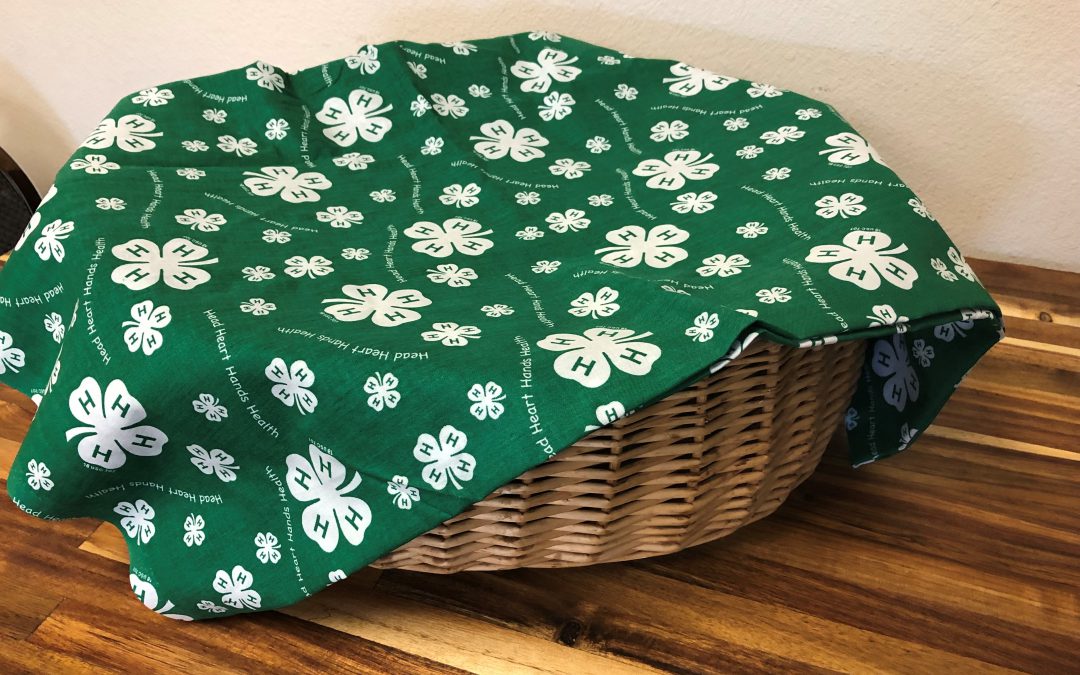
by Marie Arick | Mar 11, 2019

4-H Food Challenge Mystery Basket
Being creative in the kitchen…using a surprise set of ingredients…making a tasty dish…frequent watcher of The Food Network? Then the 4-H Food Challenge camp is the summer day camp for you!
Take a Sneak Peek
Here’s a sample list of possible ingredients in the Fruit & Vegetable category:
- 4 medium potatoes
- 1 cup carrots, sliced
- 1 cup of celery, sliced
- 1 ½ cups green bell pepper strips
- 1/3 cup onions, sliced
- 1 clove garlic, minced
- 1 tomato, cut into wedges
- 3 tablespoons of canola oil, divided
- ½ cup of water
- 2 tablespoons of low sodium soy sauce
- 1 ½ teaspoons of cornstarch
Any idea what you’d prepare? What would you name your dish?
Participants in the 4-H Food Challenge camp will work in teams with 3 to 4 members. Teams will be presented with:
- a food category
- a set of mystery ingredients
- 40 minutes to create a dish, prepare a presentation about their dish, and clean their work area
When time is up, teams will present their creation to a panel of judges describing their collaboration in creating the dish, food safety practices used by the team, how they worked together, and finally, a description of the dish including some nutrition information.
We all eat, so food safety and preparation are skills that we all need. 4-H Food Challenge campers will learn those skills along with nutrition knowledge, teamwork and presentation skills. Look for this day camp opportunity in your local UF/IFAS Extension 4-H program this summer, and join us in putting our skills to the test!
*The 4-H Food Challenge is loosely based on The Food Network show “Chopped” and adapted from the Texas 4-H Food Challenge Contest.
by Allison Leo | Nov 9, 2018
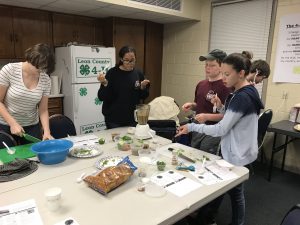
Youth making blender salsa during Leon County’s 4-H Culinary Camp
Are you having a tough time finding kid-approved snacks? With a little extra planning, you can add extra fruits, vegetables and whole grains to your child’s diet. The following snacks can be included in lunch, enjoyed as an after school snacks or as a great addition to any 4-H club meeting!
Stovetop Popcorn
It’s quick, easy, delicious AND a whole grain. Stove top popcorn is delicious just with a sprinkle of salt, but kids can get creative by adding toppings like sugar/cinnamon, Parmesan cheese or lemon zest with pepper. The United States Department of Agriculture (USDA) recommends making half of your grains whole grains each day. Here’s a simple stovetop popcorn recipe for you to try.
Snack Mix
This is another great way to get kids involved in creating their own snack mix using a variety of items. The key is to change it up every few weeks to keep kids interested. Suggested items include: chex mix, dried blueberries, raisins, chocolate chips, walnuts, pretzels, whole grain crackers, popcorn, and more. Use this snack mix recipe as inspiration.
Fruit or Vegetable Kebabs
Kids can help put together this great afterschool snack. For fruit kebabs, try grapes, apples, blueberries or kiwi. For vegetable kebabs, try green peppers, mushrooms, tomatoes or yellow squash. They can be simple with only two items such as strawberry and pineapple or cherry tomatoes and broccoli. You can dip the fruit kebabs in vanilla yogurt or drizzle them with honey. A side of ranch or hummus pairs perfectly with vegetable kebabs. The key is to purchase fruits and vegetables that are in-season to make this snack budget friendly. Here is a resource to find out what is in season in Florida.
Hummus
Let’s be honest, hummus and vegetables might not be at the top of the list of your kid’s favorite snack item. The key is to allow kids to make the hummus and serve it with a variety of items to dip. You can dip carrots, celery, radishes, pretzels, or crackers in hummus. Hummus can be made ahead and stored for a few days sealed tight in the fridge. Here is my favorite hummus recipe.
Blender Salsa
Here’s another fun way to get kids in the kitchen to make a perfect snack for after school. You can put together this recipe in less than 5 minutes – it’s so easy Try this basic blender salsa recipe, but feel free to add your own inspiration by adding extra ingredients.
Smoothies
Endless recipes make smoothies a great after school snack. You can even pack a smoothie for lunch. To ensure the smoothie stays nice and cold, place the thermos in the freezer the night before. In the morning, pour the freshly made smoothie into the frozen thermos. A personal favorite smoothie of mine is: 1 frozen banana, 1 cup milk, 1 scoop of peanut butter, 1 small scoop of cocoa powder and a handful of spinach. The spinach blends right in (you can’t even taste it), and the cocoa powder hides the color of the spinach.
Whole Grain Muffins
Whole grain muffins are an easy snack to make ahead and enjoy throughout the week. Muffins freeze well and still taste delicious when thawed. You can make chocolate chip, strawberry, blueberry, banana, pumpkin and more. Muffins can also be used as a quick breakfast while you are running out the door. For some extra protein, just add some nut butter, such as peanut or almond. Here is a delicious whole grain blueberry muffin recipe.
To learn more about 4-H’s healthy living goal, find your local UF/IFAS Extension office.
by Allison Leo | Aug 24, 2018
 Cooking with Florida Produce
Cooking with Florida Produce
Knowing how to cook and being comfortable in the kitchen is an important life skill that has enduring benefits. Leon County 4-H hosted a culinary day camp with a unique twist: educating youth about Florida produce and local agriculture. In addition to teaching culinary techniques and nutrition, youth learned foundational cooking skills and took things a step further by building connections between local farms and their kitchens.
Teaming up with Fresh from Florida Kids
Chef Paula Kendrick co-led the camp. featuring Florida-grown produce. The importance of nutrition and incorporating healthy foods into the diet was an ongoing theme during the camp. Lessons on how to read food labels, the importance of whole grain and limiting sugar intake were also featured. A salsa cooking competition using local products ended the camp. Chef Paula is from Florida Department of Agriculture and Consumer Services – Fresh from Florida Kids.
Local Farm Highlighted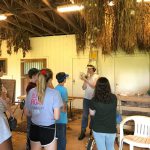
A visit to Full Earth Farm in Quincy helped youth see how a small local farm operates. Owners Katie Harris and Aaron Suko warmly welcomed the group to their farm and gave them a tour. Florida seasonality, composting benefits and how local farms provide fresh produce to businesses and homes in our area were tour highlights. The group left with a box of fresh summer squash to deliver to their next stop – Damfino’s Cafe and Market. Damfino’s sources local products for their menu items. Owner Lucy and Chef Max spoke to the group about their restaurant’s mission of connecting the local community to local farmers.
During the camp, youth were eager to try all the recipes and many of the campers tried new food items for the first time. Fresh herbs from the 4-H garden were used in a number of the recipes. Rosemary was added to honeydew sorbet, and basil was added to sautéed summer squash.
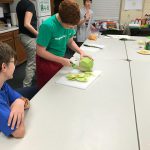 Healthy Eating is Best Learned in the Kitchen
Healthy Eating is Best Learned in the Kitchen
Chef Paula Kendrick shared, “The students got to visit a Florida farm, eat at a local Florida farm to table restaurant and learn how to handle and cook fresh Florida produce. I love helping them to make that farm to table connection while teaching them about Florida agriculture. Cooking is one of the best ways to actually get them to try new things and to understand the importance of healthy eating and nutrition.”
For more information on healthy living 4-H projects such as cooking, contact your local UF/IFAS County Extension Office.
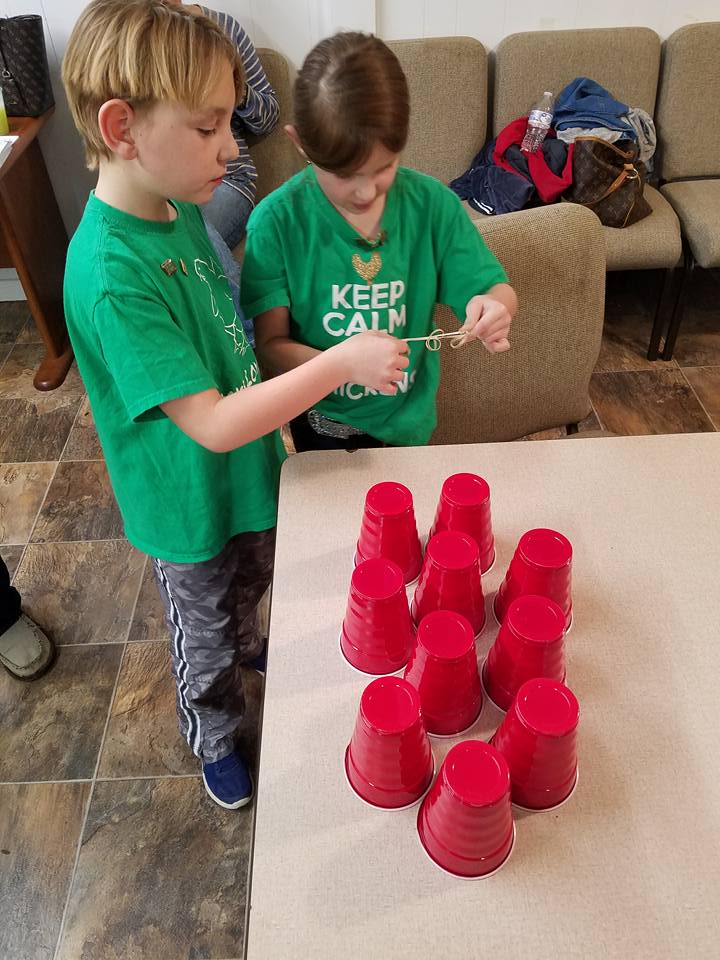
by Rachel Pienta | Jun 15, 2018
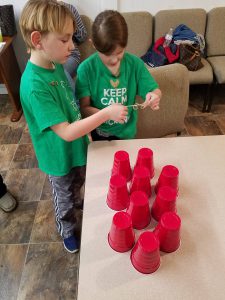
4-H members play the stacking game at a club meeting.
Summer is here, and I’m picturing long and lazy sunny days at the lake or beach. In Florida, the warm, sunny days of summer also bring afternoon thunderstorms and the possibility of tropical storms and occasional hurricanes.
What to do on rainy summer days?
During the summer months, the days of sunshine may be interrupted with periods of rainy weather. For children, rainy weather often means long hours spent inside the house. While some children welcome rainy days to spend time curled up with a book, reading for hours at a time will not occupy every child.
For parents looking for indoor activity options for children beyond movie marathons and video games, using household items already on hand can provide fun alternatives to endless screen time.
STEM CHALLENGE AT HOME
A fun activity that only requires string, rubber bands, and sturdy plastic cups will challenge your children to work together and think creatively to problem solve. The “Stack ‘Em Up: Introduction to Engineering Activity” challenges children to think like engineers. The activity is best done with 4 to 6 children. This is a great activity for children to enjoy when the neighborhood group converges on your house for a rainy afternoon! A complete instruction guide for this activity is included in the links below this article.
HOME KITCHEN CHALLENGE
A number of popular television cooking shows involve challenge competitions with special or limited ingredients. Parents can adapt this concept to help their children develop basic cooking skills while also giving them an opportunity to be creative and problem solve. This “do it yourself” at home cooking competition, adapted from PBS Kids, offers an easy fun way to engage children in creative kitchen fun:
• Divide the kids (or kids and adults) into 2 or 3 teams of 1 – 2 people.
• Gather a set of cooking items for each team – utensils, measuring instruments, bowls, etc.
• Choose an adult or older child to be the judge and/or the announcer/assistant. The judge can also decide on the “Secret Ingredient” that will be revealed to the contestants. Consider making it a fruit, a raw vegetable like carrot, cucumber, or celery, a grain item such as bread or cracker, or a spice like ginger or cinnamon.
• Set up individual or team “cooking stations”. Your cooking competition may be preparation only – without a stove, microwave, or oven.
Plan in time for taking turns cooking if your items will need to be heated or if appliances such as blenders or stand mixers will be used.
To add an additional layer of challenge, parents can decide to limit each time to one preparation method for individual teams or across all teams.
• Decide ahead of time how many additional ingredients competitors may “shop” for in the kitchen.
• Designate a separate spot for the judge or multiple judges to taste the food. This station should be equipped with a plate and eating utensils, and a palate cleanser like water or crackers. For more fun possibilities, create scoring cards with categories for taste, originality, good humor or sportsmanship, and presentation.
• Use a timing device like a kitchen or cell phone timer to add in the time element to the challenge. The suggested competition time is 20 minutes. The 20-minute time should include the child’s recipe planning time. Decisions will need to be made quickly!
• When time’s up, have each team present their creation to the judge, including a verbal description of flavors and the preparation technique. The judge(s) can taste each one and fill out the scorecards.
• Need ideas for prizes? Consider awarding a new cooking utensil like a colorful spatula with a certificate or card declaring the winner(s) “Master(s) of the Grand Spatula!”
• Want to involve additional older children or adults? Designate reporters to videotape and interview the contestants. Extend the fun by watching all the videos once the competition ends or before the winners are announced.
WHEN IT RAINS, GROW CREATIVE FUN FAMILY TIME AT HOME
The next time the summer forecast calls for rain, be prepared with these “rainy day” activity ideas. For more ideas, please contact your local UF/IFAS Extension Office.
How to Create a Cooking Challenge for Kids
How to Host a Cooking Competition for Your Kids
Stack ‘Em Up Activity
http://ngcproject.org/sites/default/files/9.6_stack_em_up_activity.pdf
https://www-tc.pbskids.org/fetch/games/activities/pdf/FETCH_StackEmUp.pdf













